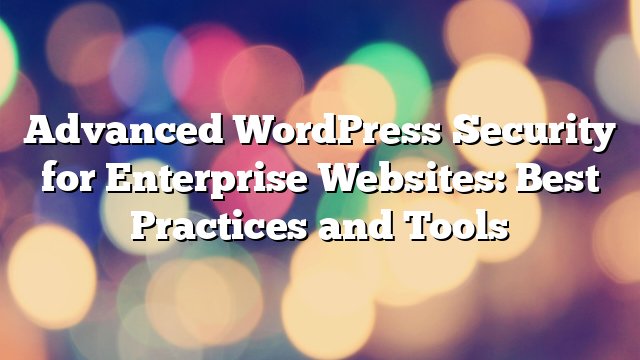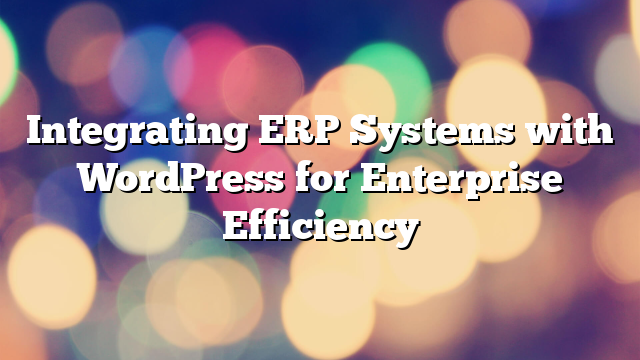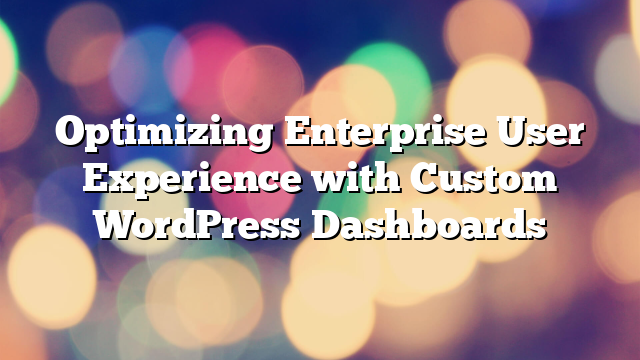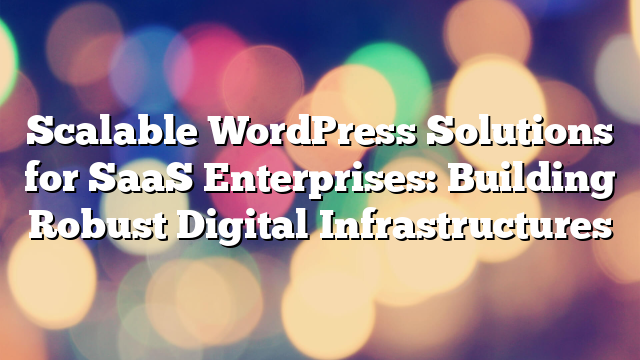Advanced WordPress Security for Enterprise Websites: Best Practices and Tools
30.04.2025

In today’s digital age, security is a critical concern for enterprises relying on WordPress for their websites. With the increase in cyber threats, data breaches, and sophisticated attacks, ensuring the security of your WordPress site is more important than ever. While WordPress is a powerful and flexible CMS, its popularity makes it a prime target for hackers. This article will outline best practices and tools to safeguard your enterprise WordPress site against potential vulnerabilities and attacks.
The Importance of Security for Enterprise WordPress Websites
Enterprise websites often store sensitive customer data, financial transactions, and proprietary business information. A security breach not only compromises the integrity of this data but also impacts brand reputation, customer trust, and financial stability. Therefore, implementing robust security measures is crucial for protecting both the business and its users.
Common Security Threats to WordPress Websites
Understanding the various threats that can target your WordPress site is the first step in securing it. Here are some of the most common security risks:
- Brute Force Attacks: Hackers attempt to guess your WordPress login credentials by trying numerous username and password combinations.
- SQL Injection: Malicious code is injected into your WordPress database, enabling attackers to manipulate data or access sensitive information.
- Cross-Site Scripting (XSS): Attackers inject malicious scripts into your website that can affect visitors and steal sensitive data.
- Malware: Malicious software installed on your website can cause data loss, site downtime, and the spreading of viruses to users.
- Outdated Plugins and Themes: Vulnerabilities in plugins and themes are common targets for attackers. If these components are not kept updated, they can expose the site to security risks.
Best Practices for Enhancing WordPress Security
By following a few simple yet effective security practices, you can significantly reduce the risk of these threats. Below are essential tips for securing your WordPress enterprise website:
1. Keep WordPress, Themes, and Plugins Updated
WordPress regularly releases updates to patch security vulnerabilities and improve site performance. It’s essential to keep your WordPress installation, themes, and plugins up to date to ensure they are not susceptible to known vulnerabilities. You can enable automatic updates for minor WordPress releases, but it’s important to test major updates in a staging environment before applying them to a live site.
2. Use Strong Passwords and Two-Factor Authentication (2FA)
Using strong passwords is one of the easiest and most effective ways to protect your site from unauthorized access. A strong password should include a mix of uppercase and lowercase letters, numbers, and special characters. Additionally, enable Two-Factor Authentication (2FA) for an extra layer of protection. With 2FA, users must verify their identity using a second factor (such as a smartphone app) in addition to their password.
3. Limit Login Attempts
Brute force attacks are common on WordPress sites, where attackers attempt to gain access by guessing the username and password. To prevent this, limit the number of login attempts allowed. If an incorrect login attempt exceeds a predefined number, the system should temporarily lock the user out. Plugins like Limit Login Attempts Reloaded can help automate this process.
4. Install a Web Application Firewall (WAF)
A Web Application Firewall (WAF) acts as a barrier between your website and the internet, filtering out malicious traffic before it reaches your server. It can help block common attacks like SQL injections, XSS, and other threats. Cloud-based firewalls like Cloudflare or Sucuri provide advanced protection against hacking attempts and malicious bots.
5. Secure Your WordPress Login Page
The login page is one of the most common attack vectors on WordPress websites. To enhance security, consider the following:
- Change the Default Login URL: WordPress default login URL (/wp-login.php) is well-known to attackers. You can change it to something unique with plugins like WPS Hide Login.
- Use ReCAPTCHA: Adding Google reCAPTCHA to your login page will prevent automated bots from attempting to login using brute force techniques.
6. Backup Your Website Regularly
No matter how strong your security measures are, having regular backups is essential. In case your website is compromised, having a recent backup allows you to quickly restore your site to its previous state. Use reliable backup solutions like UpdraftPlus or BackupBuddy to schedule automated backups of your site and store them off-site for added security.
7. Monitor and Scan for Malware
Regularly scanning your website for malware is crucial to detect and remove malicious code before it causes damage. There are various plugins available for this task, such as Wordfence and MalCare, which scan your website for malware and vulnerabilities. Additionally, using services like Google Search Console can alert you if your site is marked as suspicious or infected.
8. Use SSL Certificates
SSL certificates ensure that data transferred between your website and its visitors is encrypted. This is especially important for enterprise websites that handle sensitive customer data. Google also considers SSL a ranking factor, so implementing HTTPS can improve your site’s SEO. Most hosting providers offer free SSL certificates via Let’s Encrypt, or you can purchase an SSL certificate from other trusted providers.
9. Secure Your Hosting Environment
Choosing a secure hosting provider is crucial for protecting your website. Many managed WordPress hosts provide built-in security features like automatic backups, malware scanning, and server-level firewalls. Additionally, ensure your hosting environment uses the latest server-side security practices, such as the latest PHP version and file permission settings.
10. Limit User Permissions
WordPress allows you to manage user roles and permissions, but not all users need full access to your site’s back end. Limit user access to only the permissions necessary for their role. Regularly audit user roles to ensure that only trusted personnel have access to sensitive areas of your website.
Essential Tools for Securing Your WordPress Enterprise Site
Several security tools can help automate and enhance the security of your enterprise WordPress website. Here are some top choices:
- Wordfence: A comprehensive security plugin offering a firewall, malware scanner, and login protection.
- iThemes Security: Offers more than 30 ways to secure your WordPress site, including file integrity monitoring and database backups.
- Sucuri Security: Provides website security monitoring, malware removal, and DDoS protection.
- Cloudflare: A cloud-based security service that provides a firewall, caching, and protection from malicious attacks.
Conclusion: A Proactive Approach to WordPress Security
Security is not something to take lightly, especially when running an enterprise website. By implementing these best practices, using security tools, and staying up-to-date on the latest threats, you can significantly reduce the risk of a successful attack. Protecting your WordPress site is an ongoing process, but with the right strategies and vigilance, you can ensure that your enterprise website remains secure, reliable, and ready for growth.
If you need expert assistance in securing your enterprise WordPress site, Vipe Studio offers tailored security solutions to keep your website safe and secure.



